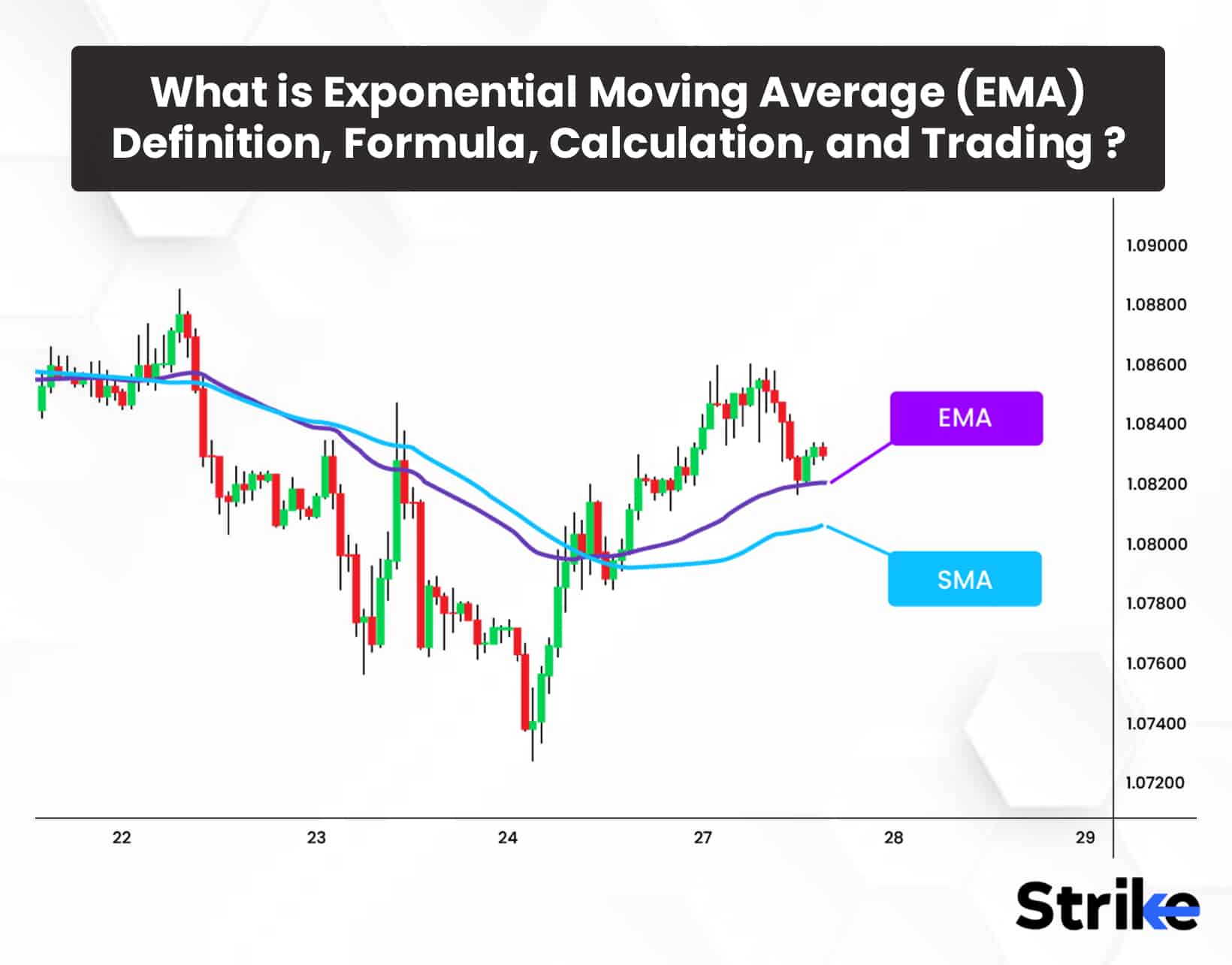
The Exponential Moving Average (EMA) is a technical chart indicator that helps traders to monitor the price of financial securities over a period of time. The Exponential Moving Average belongs to the Moving Average type of technical indicators. The Moving Average indicators are all technical indicators that help investors and traders smooth out the price data over a period of time using the arithmetic average of the prices. The Simple Moving Average calculates the average of the security’s price over a span of time, while the Exponential Moving Average places more significance on recent price data.
The EMA is one of the most used and reliable indicators. It is popularly used in day trading or lower time frames also.
The EMA works by producing buy and sells signals, determining the direction of the price movement based on price data from the past. The formula for calculating the EMA is
EMA = Closing price * multiplier + EMA (previous day) * (1-multiplier), where the multiplier is calculated using the formula 2 / (number of observations +1).
What is Exponential Moving Average (EMA)?
The Exponential Moving Average(EMA) is a technical chart indicator that produces buy and sell signals by tracking the price of a security over a period of time. The EMA determines buy and sell signals based on divergences and crossovers in the past average. The EMA is used for different time frames, and its signals vary with the chosen time frame. The EMA is a type of moving average indicator. The EMA gives greater significance to recent price data as compared to the Simple Moving Average.
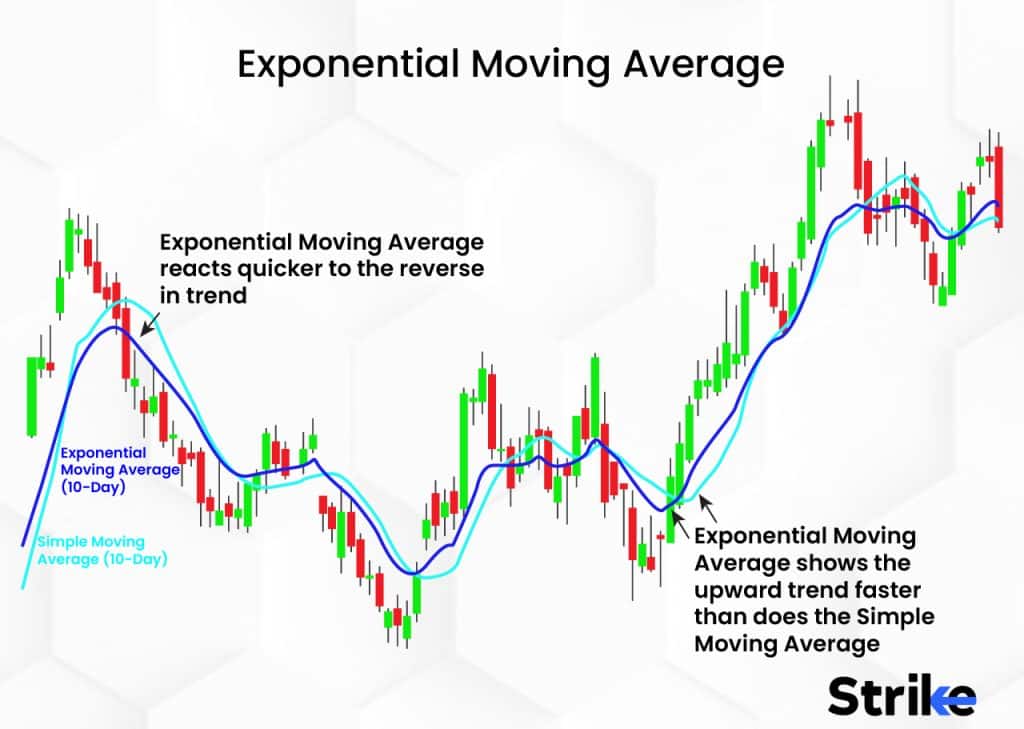
Is EMA the same as EWMA?
Yes, the Exponential Moving Average (EMA) is the same as the Exponentially Weighted Moving Average (EWMA). The EMA is also called the EWMA as it places more weight on the recent price data points as opposed to the Simple moving average (SMA), which gives equal weightage to all price data points in a period.
How does an Exponential Moving Average (EMA) work?
The EMA works by placing weight on recent data points. The EMA functions by producing buy and sells signals based on the crossovers and divergences it plots against the historical average. Traders and investors can use the EMA for short, specific time periods, as it can reflect even small price fluctuations. The image below shows the chart plotted by the EMA.
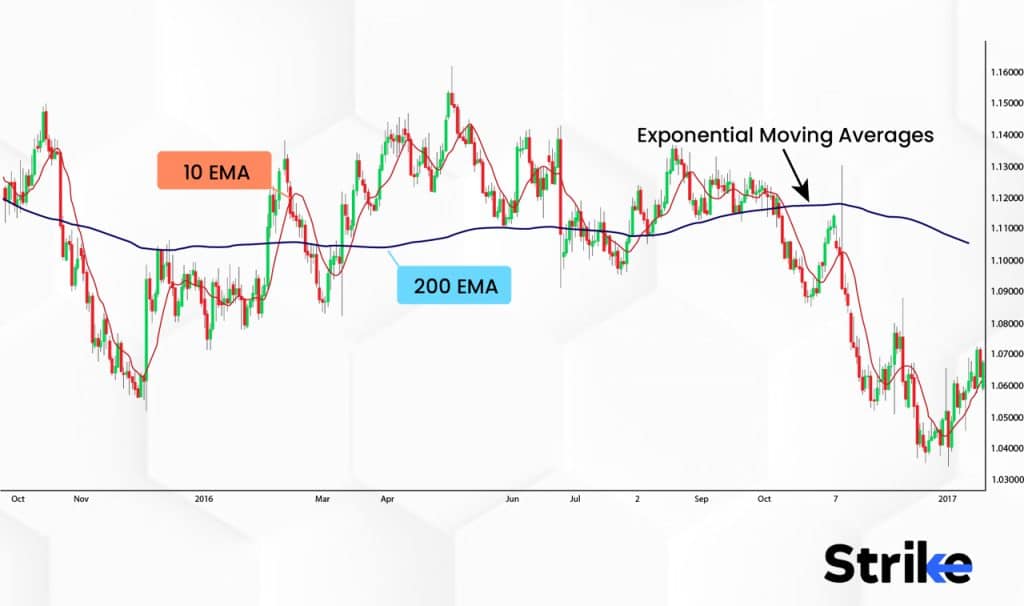
The black line of the chart represents the EMA that has been plotted for a period of 20 days. The EMA, as the image shows, smooths out the price data over the defined period of time. The boxes on the intersection of price / candle and black line represents potential trading opportunities generated by the indicator.
How important is Exponential Moving Average (EMA) in Technical Analysis?
The Exponential Moving Average (EMA) is a very important and powerful tool in technical analysis mainly owing to its ability to produce buy and sell signals based on recent data points. The EMA is particularly used for short time frames and especially for intraday traders as it is more sensitive to price changes than the Simple Moving Average(SMA). The main importance of the EMA stems from its ability to reflect recent price movements.
Several trading positions which the SMA fails to reflect are captured by the EMA. The EMA is also a vital tool for traders who seek to measure the strengths of trends. Traders can analyze the price chart with the EMA to understand support and resistance levels will help them to frame their trading strategies as well entry and exit positions. EMA’s also give assistance in risk management in terms of placing of stop losses in case of trades taken by watching EMA.
What is the formula for calculating EMA?
The formula for calculating the EMA is
EMA = Closing price * multiplier + EMA (previous day) * (1-multiplier). The multiplier is calculated using the formula 2 / (number of observations +1). The formula for calculating EMA requires one more observation as compared to the formula for calculating SMA, which is a simple arithmetic average. The EMA for 10 days, for example, is calculated by first calculating the SMA for 10 days. The EMA can then be calculated on the 11th day by using the SMA for the 10 days as the previous EMA. The multiplier is used in the formula to smooth out the EMA while giving more significance to the recent data points. The EMA weighting given to recent data points is highest when the time frame is short. The image below shows another version of the formula to calculate the EMA.

The ‘N’ in the formula above denotes the number of days for which the EMA is to be calculated. The formula for the multiplier has been substituted in the formula above for this version of the formula for EMA.
How to calculate EMA?
There are mainly three steps to follow when calculating the EMA, including calculating the SMA, the multiplier, and finally applying the two to the formula to calculate the EMA. Calculating the EMA is slightly more complicated than calculating the SMA. The calculation of the EMA first involves calculating the SMA for the same time period. The SMA is calculated by computing the arithmetic average of a security’s prices over the specified period of time. The formula for calculating SMA is SMA = (P1 + P2 + P3 + …….. PN)/N, where P is the price of the security each day for a specific number of days and N is the specific number of days.
The second step in calculating the EMA is to calculate the multiplier, which is used to place more weight on the recent price data. The multiplier is calculated using the formula Multiplier = 2/(N-1), where N is the number of days for which the EMA is to be calculated.
The last and final step in calculating the EMA is to apply the SMA and multiplier to the EMA formula. The SMA is used as the previous EMA in the formula. The formula for calculating EMA is EMA = (current or close price * multiplier) + [EMA previous * (1- multiplier)]. Calculating EMA needs one more observation as compared to calculating SMA, as the SMA for the desired number of days acts as the EMA previous in the EMA formula. The EMA is calculated for different periods of time, as desired using the EMA formula.
Though this remains a mathematical and theoretical subject. All the systems in today’s era of capital markets provide automatically generated EMA’s as per user’s choice of period of days.
What is an example of a 200-day Exponential Moving Average (EMA) calculation?
To calculate the EMA, we first need the simple moving average (SMA) of the closing prices over the lookback period, which is just the average of the 200 closing prices. Let’s say the 200-day SMA is ₹2,100.
The EMA formula gives more weight to recent prices. It is: EMA = (Closing Price x Smoothing Factor) + (Previous EMA x (1 – Smoothing Factor)).
The smoothing factor for a 200-day EMA is 2/(200+1) = 0.0099.
Let’s say the previous 200-day EMA was ₹2,080.
The current EMA is: (₹2,100 x 0.0099) + (₹2,080 x (1 – 0.0099)) = ₹2,097
So the updated 200-day EMA is ₹2,097.
What is an example of a 50-day Exponential Moving Average (EMA) calculation?
We take the same approach but with a 50-day lookback. The smoothing factor for a 50-day EMA is 2/(50+1) = 0.0392.
If the 50 day SMA is ₹2,150 and previous 50-day EMA is ₹2,125, the current 50 day EMA is:
(₹2,150 x 0.0392) + (₹2,125 x (1 – 0.0392)) = ₹2,148
So the new 50-day EMA becomes ₹2,148.
What role do EMAs play in Algorithmic Trading?
EMA’s play a crucial role In algorithmic Trading as EMA’s are mathematically derived prices, algo’s are used to deduce this price and use this price to take trades and exit trades. These also work in all the types of capital markets; Forex, Cryptocurrencies, Stocks and Derivatives. Even though EMA’s are one of the lagging indicators, EMA’s are reliably used by day traders extensively as they give proper entry and exit points and also provide safe stop losses.
Algorithmic trading is advancing fast and even the retail participants are shifting their executionary style of trading into algorithmic form of trading. Algo’s can be systemized in such a way that if the price of a stock is trending, EMA’s are used as an entry during retracements. The algo will automatically execute buy or sell orders when the script’s price touches the EMA (price reflecting ema). The algo also takes care of stop losses. If an algo is coded in a way, that if a price of a stock breaches an EMA, at a certain percentage, the positions will be exited when the specific conditions based on EMA prices are met.
How to use EMA in Trading?
There are mainly three steps to follow to use the EMA for trading, including opening the stock price chart, applying the EMA and studying the graph, and then studying the chart to identify the buy and sell points. The three steps are listed in detail below.
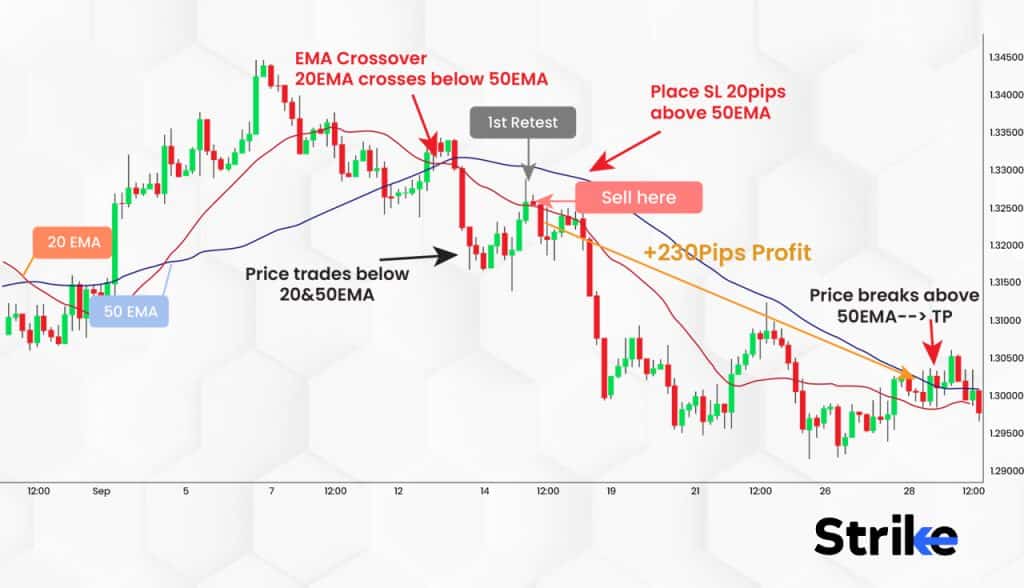
- Open the security’s price chart
The first step in order to use EMA for trading is to open the price chart of the desired security. A price chart shows the traders the variations of the prices across time. Price charts clearly depict the fluctuations in the security’s prices.
- Apply EMA to the price chart
The second step is to apply the EMA to the price chart by choosing the option from the technical indicators available. The EMA will then be visible as a graph on the price chart. The image below shows what a price chart looks like when the EMA has been applied to the price chart of the Banknifty chart.
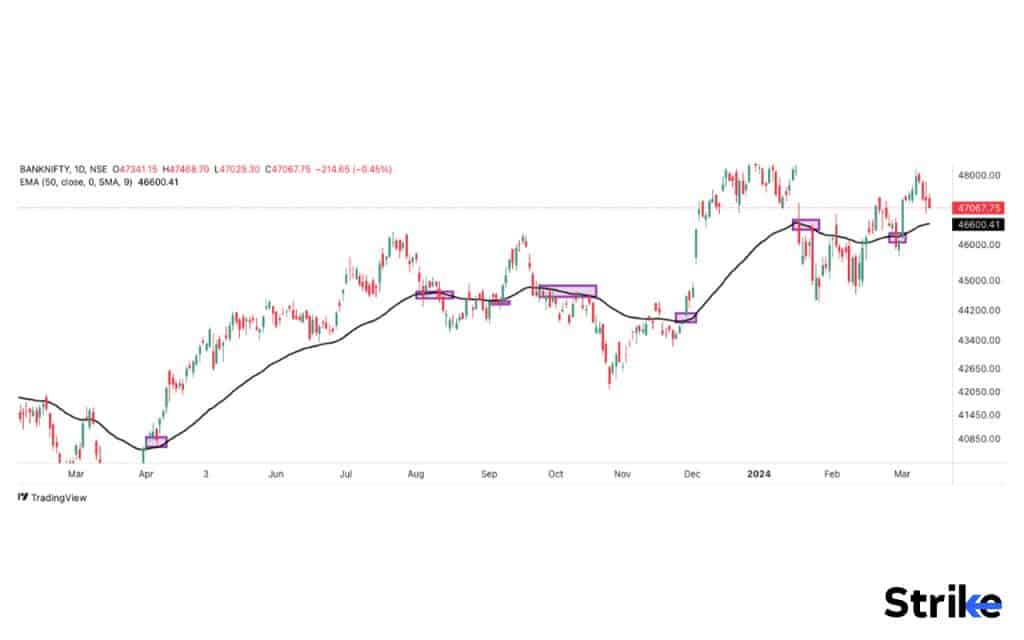
The blue line in the image above indicates the EMA. The EMA, here, has been generated for a 50-day period.
The Purple Boxes represents no. of times EMA generated a probable trade on a buy or sell side during either a breakout or during retracements. Of course, other confluences are gathered to solidify a trade. But EMA stands as a classic indicator to give reliable trading signals.
- Identify crossovers
The last and final step is to identify crossovers of the EMA from the price chart itself. The price trend is bullish when the EMA of the Lower Period (25 day period / orange line) crosses the price line from below to above, and the price trend is bearish when the EMA of the Higher Period (50 day period / green line) crosses the price line from above to below as in the example in the image below. Traders take the bullish trend prediction as a buy signal and the bearish trend prediction as a sell signal. The blue crosses in the image below represent bullish and bearish crossovers as signals.
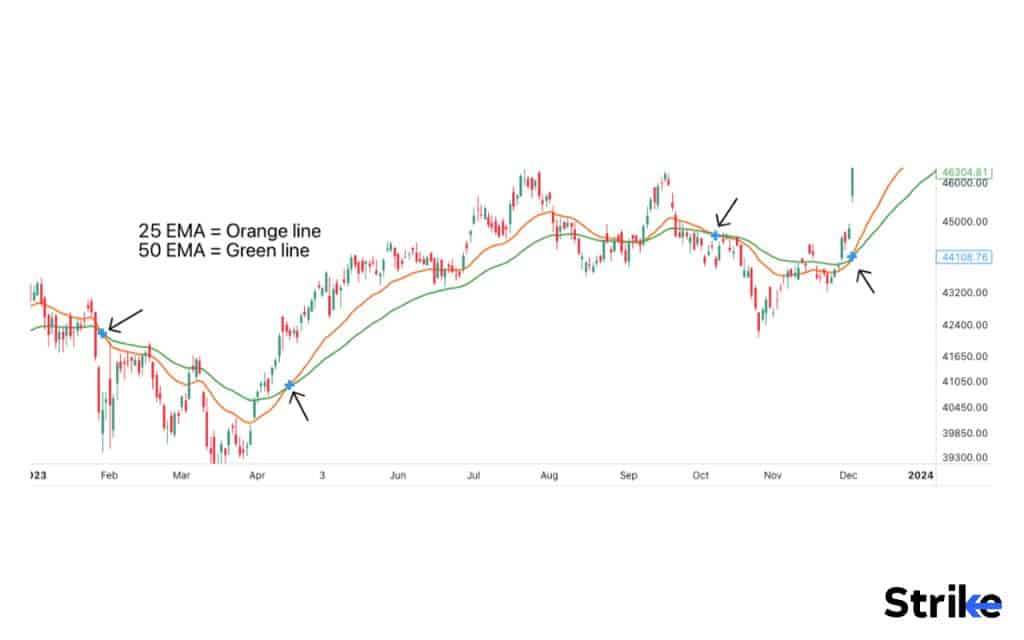
Traders using the EMA must, however, keep in mind that the EMA is a lagging indicator and is not suitable for identifying trading positions when used in isolation. It is often only after the time for making an entry or exit has passed that the EMA reflects it.
Strike.money is one of the scanners that provide a list of stocks that are above or below the EMA, Crossing above or Crossing below the EMA as well. This way, the trader’s time for selecting stocks is reduced drastically and thus they will be able to analyze the list of stocks as per other criteria before executing the trade. The image uploaded below scans the list of stocks that are above the 10 period EMA. Default periods available on strike.money are 10,20,30,40,50,100 and 200 EMA respectively.
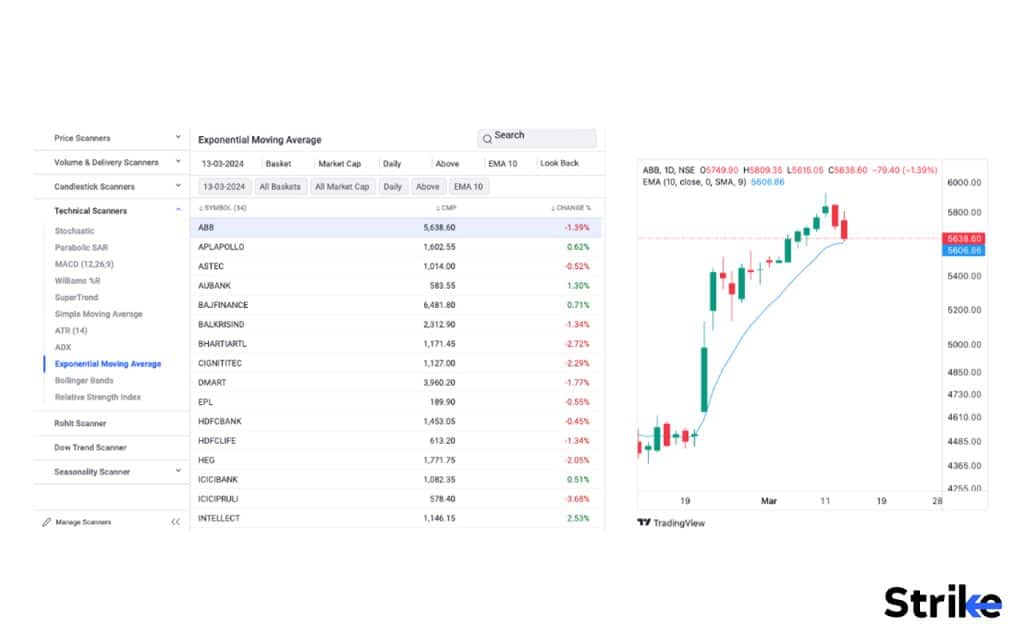
The drop down menu below Daily provides the list of different time frames like Hourly, Daily, Weekly, Monthly.
The drop down menu below EMA 10 provides the list of different time periods like 10, 20, 30, 40, 50, 100 and 200 Period EMA’s respectively.
How can EMAs be used to identify trends?
EMA are used in trading mainly to identify trends as well as to identify buy and sell positions. Crossovers with the price movement tend to indicate buy positions, whereas divergences with the price movement indicate sell positions. The image below indicates how the EMA are used to identify trends and locate buy and sell positions.
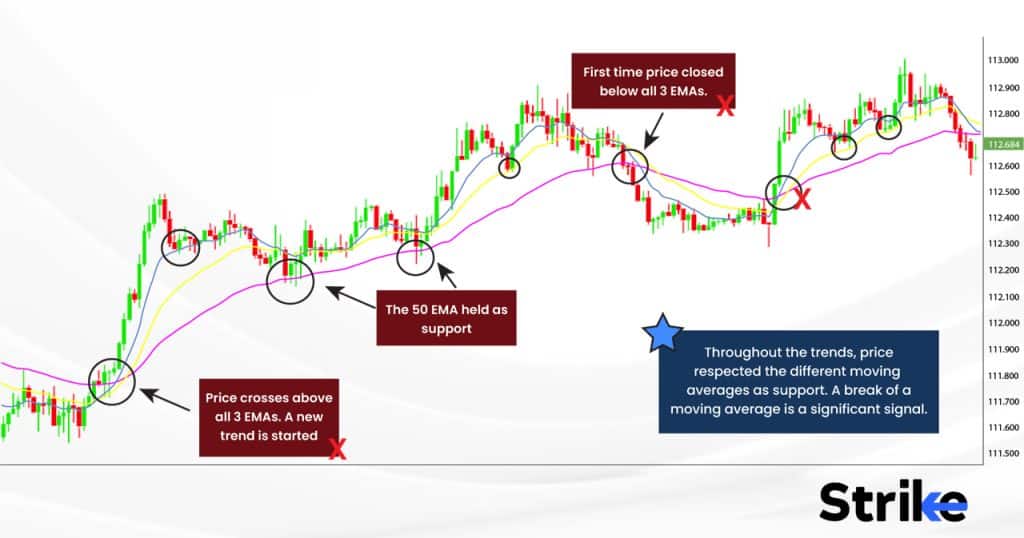
The graph above shows that a decline in prices is accompanied by a falling EMA denoted by a black arrow.
An advance in price is accompanied by an advancing EMA denoted by a black arrow. The Purple Boxes represent the trade signals generated by the EMA. Either the breakout trades or the retracements.
The EMA, however, is a lagging indicator, and the signals are often more suited to confirming a market move or testing its strength. The exact time for making entries and exits is very often over by the time the EMA reflects the movements. The EMA does, however, react more quickly to recent price moves than a SMA, owing to the multiplier that is applied to its formula.
How is the length of an EMA determined?
The length of an EMA is determined by the trader’s investment strategy. Traders who have long-term investment strategies tend to use time frames ranging from 50 to 200-day periods. Short-term traders and intraday traders, on the other hand, tend to utilise shorter time periods ranging from 15 minutes to 10 or 20 days.
Short term traders and intraday traders may also use higher period EMA’s as they provide crispier signals on Lower Time Frames in contrast to lower period EMA’s as they can provide multiple false signals during a ranging markets.
How do traders adjust their EMA strategy based on market volatility?
Traders tend to adjust their EMA strategy based on market volatility, mainly by adjusting the time frame. Traders make the time frames for the EMA shorter during periods of market volatility so that even the indicator is more sensitive to the smallest of changes. The recent price movements are captured more accurately when the time period of the EMA is kept shorter.
During higher volatility situations, traders often toggle between higher and lower time frames and find possible presence of ema. The fluctuations between these EMA’s with respect to different time frames is captured. Meaning, the value of 50 EMA is different with different time frames. Supposedly, the value of 50 EMA on a 15min chart time frame is different from the value of 50 EMA on 1hour or any other time frame.
What time frames are commonly used for EMAs?
Commonly used EMAs include the 12- or 26-day EMA, which are typically relied on by short-term traders, while the ever-popular 50-day and 200-day EMA is used by long-term investors.
How can EMAs be used in conjunction with other Technical Analysis Indicators?
EMAs must ideally be used in conjunction with other technical indicators to ensure that the EMA signals are correct. EMAs are lagging indicators that help confirm market trends. Investors and traders who use the EMA must ideally use it along with other types of indicators which can complement the results it produces. Examples of other indicators which are used with the EMA include momentum indicators such as the Relative Strength Indicator (RSI), the average directional index (ADX), or the moving average convergence divergence (MACD), which can preempt upcoming market changes.
They can also be combined with demand or supply levels as a stronger confluence alongside other technical indicators.
Which Indicator works best with the EMA?
The indicators that work best with the EMA are momentum-based indicators. Momentum-based indicators like the Relative Strength Indicator (RSI), the average directional index (ADX), or the moving average convergence divergence (MACD) have the ability to predict upcoming market changes, which helps especially since the EMA is a lagging indicator. Lagging indicators only identify trends after a trend change has already occurred. Traders can get a more accurate and comprehensive result by combining two different types of indicators.
What are the advantages of EMA?
There are primarily four main advantages to the EMA, including its ability to respond quickly to price fluctuations, its suitability for intraday trading, its ability to identify the trends in the price movement as well as its ability to be used in different time frames. All the advantages of the EMA are rooted in its ability to reflect recent price fluctuations quickly. The four main advantages are listed in detail below.
- Ability to respond quickly to price fluctuations
One of the key advantages of the EMA is that it is able to respond quickly to recent price fluctuations. EMAs with shorter time frames, in particular, are highly effective in reflecting even the smallest of price fluctuations, owing to the multiplier that is used in the formula to obtain the EMA. The EMA is therefore more effective in negating the impact of the lag when compared to the SMA.
- Suitability for intraday trading
Another advantage of the EMA is its suitability for intraday trading. The EMA’s ability to reflect small price fluctuations accurately makes it an invaluable tool for intraday traders.
- Ability to identify trends in price movement
The EMA, like all technical indicators belonging to the Moving Average type, helps identify the ongoing market trend. The EMA is thus able to help traders make trading decisions by confirming the price movement as well as aiding in assessing the strength of the market trend.
- Ability to be used in different time frames
Another key advantage of the EMA is that it is used for a wide range of time frames, ranging from a few minutes to hours, days, and months. EMAs are thus useful tools for investors and traders with both long and short-term trading strategies.
Other advantages of the EMA include its simplicity and comprehensibility as well as its ability to identify support and resistance levels. The EMA is easily understood by even beginners in trading. Traders can also identify potential entry and exit points as well as support and resistance levels by studying the EMA along with the price chart of the security.
What are the disadvantages of EMA?
The three main disadvantages of the EMA include its tendency to produce false and conflicting signals, its inability to account for price gaps, as well as its inability to predict future price movements. The disadvantages are listed in detail below.
- Tendency to produce false and conflicting signals
One of the main disadvantages of the EMA is its tendency to produce faulty and conflicting signals. The EMA places more weight on recent price data, as a result of which it is more susceptible to recent spikes and changes in prices. The EMA, very often, tends to produce false or conflicting signals owing to the effect spikes and outliers have on it, particularly when compared to the SMA.
- Inability to account for price gaps
Another main disadvantage of the EMA is that it is unable to account for price gaps. Outliers, which are points on the price chart far away from the main body, are formed when prices jump from one point to another in between trading sessions. The EMA calculates price as a continuous factor and therefore doesn’t make any allowance for outliers, often leading to conflicting signals.
- Inability to predict future prices
The third main disadvantage of the EMA is its inability to predict future prices. The EMA, being a lagging indicator, can only help identify market trends and evaluate their strength. The EMA can make no predictions about the upcoming changes in price movements.
The disadvantages of the EMA can be overcome by using other technical indicators along with the EMA. Momentum-based indicators like the MACD or the ADX can complement the results produced by the EMA and help traders obtain a comprehensive understanding of the market and the situation before making trading decisions.
Can EMAs be used to predict future price movements?
No, EMAs cannot accurately predict future price movements on their own. No indicator can accurately predict future price movements. EMAs are lagging indicators that follow past price action. However, EMAs can give clues about the potential future momentum of a trend when used in combination with other indicators and analysis techniques. But overall, EMAs should not be relied upon alone to predict ahead.
Can EMAs be used to identify support and resistance levels?
Yes, Value of EMA’s do work as effective support and resistance prices. They can work in conjunction with existing price action based demand and supply. If both; the EMA and the demand or supply represent the same price increases the strength of the price to direct the further direction or trend of the script.
Can EMAs be used in combination with Candlestick Patterns?
Yes, EMA’s can be used in combination with candlestick patterns to solidify a view about future direction of the script’s price. They may act as an added confirmation or confluence to have a stronger edge to generate a trading signal.
Is the EMA better than the SMA Day Trading?
Yes, the EMA is better than the SMA for day trading, as the EMA places greater weight on recent price movements. The EMA is thus more sensitive to recent fluctuations in prices, making it a more useful tool for intraday traders.
What is the difference between Exponential Moving Average (EMA) and Simple Moving Average (SMA)?
The EMA and SMA are both lagging indicators that use past prices in their calculations, but there are some notable distinctions between the two.
The main difference is that the EMA prioritizes more recent prices by applying greater weight to the most recent data points. In contrast, the SMA treats all data points equally over the lookback period. This means the EMA reacts faster to price changes than the slower-moving SMA.
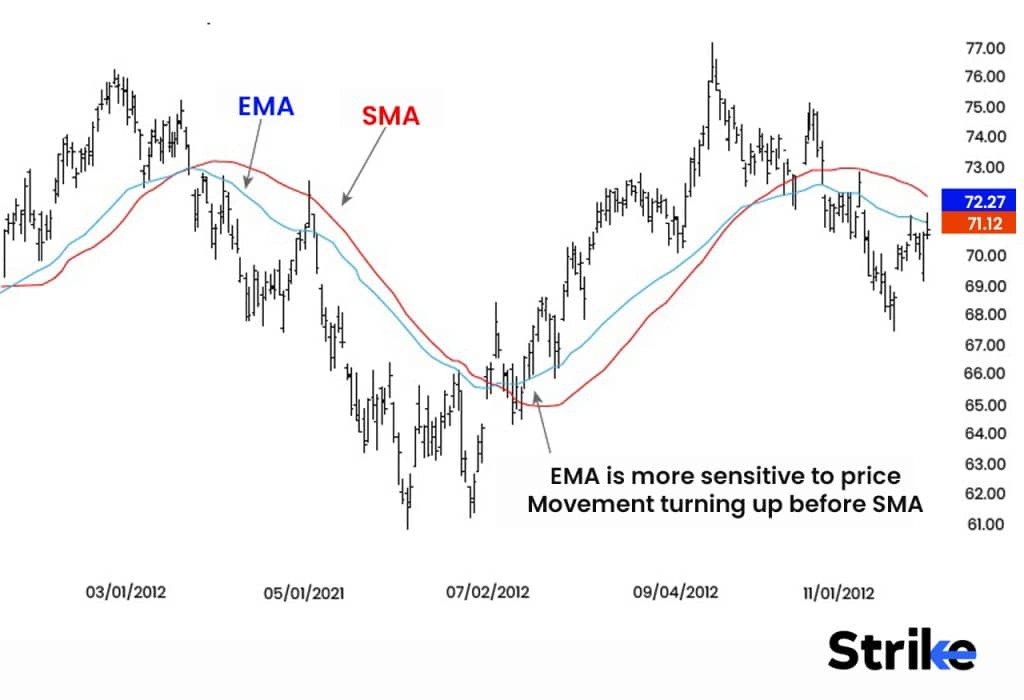
Due to its sensitivity, the EMA is more suitable for short-term trading and capturing shifts in momentum, while the smoother SMA aligns better with long-term investors looking at the bigger picture. Additionally, the inherent lag is reduced in the EMA compared to the SMA due to the exponential weighting. In summary, the EMA places higher significance on the most recent prices, making it more reactive and better for short-term traders, while the SMA weights all data evenly, making it a steadier indicator preferred by long-term investors.




![85 Common Stock Market Terminologies for Dummies [Updated List for 2026] 106 85 Common Stock Market Terminologies for Dummies [Updated List for 2025]](https://www.strike.money/wp-content/uploads/2025/04/Popular-Stock-Market-Terms-for-Beginners-Banner.png)










No Comments Yet.